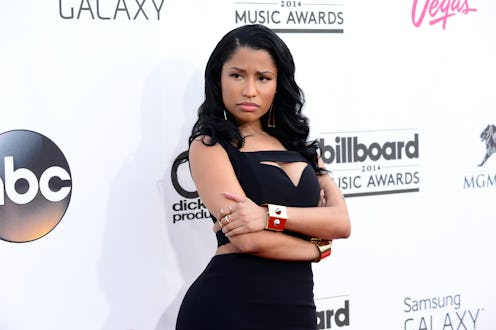News
Nicki Minaj's Headdress Causes Controvery
Nicki Minaj obviously knows how to cause a stir and get people talking. And she's done nothing less with the announcement for her 2015 Pinkprint European Tour. News of the tour arrived yesterday, along with the sharing of its main advertisement on Minaj's Twitter — a poster that's causing the very controversy. In said poster, Minaj is topless with her hair covering her breasts. She is wearing only a feathered headdress. So basically, it appears as though she has learned nothing about double-checking her promotional materials after the disaster that was the "Only" video's Nazi imagery.
The headdress immediately drew criticism from Indigenous media and sparked the conversation about cultural appropriation anew. Yes, again. Is there something that I'm missing that's making it difficult for celebrities (and lots of other humans) to understand that wearing a war bonnet replica is not OK? This year, a Canadian music festival banned all headdresses, and though Glastonbury didn't quite go as far, the super-festival still made a step in the right direction by disallowing the sale of all headdresses on its premises. The conversation expanded on Twitter and Tumblr yesterday (obviously) to question whether or not Minaj's headpiece was appropriative or a Carnivale-style headdress representative of her Trinidadian roots. She wore a colorful Trinidadian piece in the "Pound the Alarm" video, after all. But said piece is noticeably different from the one she is seen sporting in the latest tour poster.
The headdress's lack of colorful feathers and jeweled embellishments — along with the addition of the designer's trademark wild turkey feathers and what have been identified as eagle feathers (which are extremely sacred) — makes it seem like it's less likely to be a homage to Nicki's homeland. And more likely to be yet another example of an appropriative no-no.
By now, if Minaj — or anyone else for that matter — doesn't understand why it's not alright to wear war-bonnet-inspired headwear, we're just going to have to deem this an execution of willful ignorance. There are resources online that spell it out as plainly as possible. Indigenous leaders and First Nations Chiefs have spoken out about the cultural significance of war bonnets and headdresses time and time again. It's not hard to do a quick internet search, right? And when you're as famous, loaded and powerful as Minaj happens to be, I'm pretty sure there are people who do that for you anyway.
There are two things about this specific use of Indigenous cultural and spiritual symbols that are particularly problematic. The first being that the piece was created by a designer who isn't of First Nations descent, who is profiting off of the sale of huge, war bonnet-style headdresses. Yes, people may argue that because they lack the beadwork typical to most Plains First Nations war bonnets that everything's OK — that it's totally fine for a designer to create headdresses that are "inspired" by the originals, as long as they're not exact copies. Right?
Sure, it's better to purchase dreamcatchers or moccasins from Indigenous artists instead of buying cheap knockoffs from the mall. But here's the thing about war bonnets — almost certainly, you'd be unable to buy one from an Indigenous artist even if you wanted to. One of the reasons traditional war bonnets are so significant is that they can't be bought: they have to be earned. The eagle feathers that make up war bonnets are incredibly rare and significant — in the United States and Canada, it's illegal for anyone other than the member of a tribe to even own them. The feathers are earned for acts of courage and bravery, or for noble actions that improve the life of the entire tribe. It's actually kind of appalling for a non-Indigenous person to commodify (and then profit off of) the sale of items that mimic something with such significance.
The other aspect of this image, and of Minaj wearing a headdress and nothing else, that is so problematic is the current epidemic of violence against Indigenous girls and women. Just last month, 17-year-old Rinelle Harper was sexually assaulted, thrown in a river and left to die. She's a survivor, but over 1000 Indigenous women (a low estimate) in Canada went missing or were murdered these past 30 years. What's one of the reasons that academics and activists say is contributing to this? The sexualization of Indigenous girls and women.
"This is not just about cultural appropriation. This is about a serious, scary, and continuing legacy of violence against women in Indian Country... By perpetuating the stereotypes of Native women as sexual objects, they are aiding and continuing the cycle of violence," wrote Cherokee scholar Dr. Adrienne Keene on her blog, Native Appropriations. Sure, it's nice for a celebrity like Minaj or Khloe Kardashian to feel sexy and bold enough to pose topless — but doing so whilst wearing a warbonnet is tying an Indigenous cultural symbol to a sexualized image. And when people are hyper-sexualized, it makes it easier for others to dehumanize and objectify them. Because is it easier to harm a person or an object?
While women who wear war bonnets may truly be ignorant of the abhorrent statistical probability of a First Nations woman facing violence, that's not a good enough excuse anymore. We all can and should do more to educate ourselves on the history of the land in which we live, and of the culture of those who lived here first. Now that we know better, it's about time we start doing better, too.
